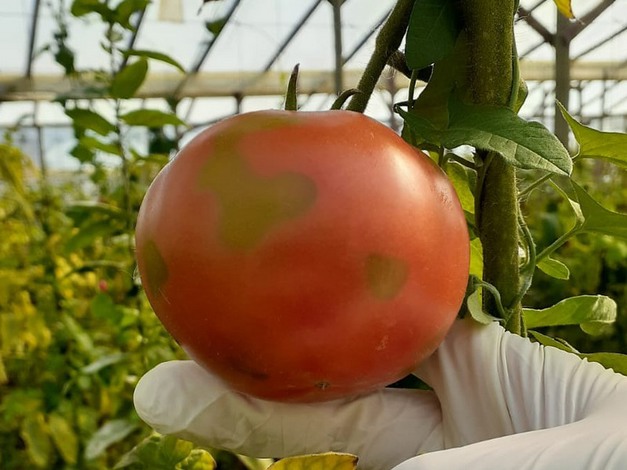The National Agri-Food Health and Quality Service (Senasa) confirmed the detection of the tomato rugose virus (ToBRFV) after a laboratory analysis in the town of Orán, in the Salta province.

Picture: SENASA
The findings correspond to samples collected from a single tomato plantation that presented symptoms compatible with the virus. As a preventive measure, and within the framework of Senasa Resolution No. 569/2023, it was ordered that production establishments keep the production sites where the virus was detected in isolation.
Tomato brown rugose fruit virus (ToBRFV) was first detected in Israel (2014) and Jordan (2015). In tomato cultivation, the symptoms vary depending on the variety. On leaves, they are manifested by chlorosis, mosaic, and mottling with narrowing of the leaves. Sometimes necrotic spots appear on peduncles, calyxes, and petioles. On the fruit, yellow or brown spots are observed, with rough symptoms that make the fruits unmarketable. The fruit may be deformed and have irregular ripening.
Senasa established rigorous hygiene and disinfection measures in the place, as well as in work tools and other elements that may act as possible transmitters of the virus. In July of this year, through Resolution 569/2023, Senasa declared a phytosanitary alert for the entire national territory in relation to the disease.
This measure seeks to strengthen joint actions between the public and private sectors with the objective of determining the current situation of ToBRFV in the country, containing and eradicating outbreaks that are eventually detected, and preventing its establishment and dispersal.
In this sense, Senasa committed to working closely with producers and society in general to report on the situation, share prevention and control measures, and guarantee food safety in tomato production. Early detection and coordinated actions are essential to protect agriculture and the local economy.
Since the detection of the virus in Argentina, Senasa, together with INTA and INASE, have worked in a coordinated manner to prevent this disease. In this way, an inter-institutional crisis committee was also created, an action that makes the monitoring and prevention work even more intensive and coordinated. Likewise, contact with producers, technical support, and communication actions are also the product of joint work between the institutions.
Source: clarin.com
